![]()
![]()
![]()
Use LEFT and RIGHT arrow keys to navigate between flashcards;
Use UP and DOWN arrow keys to flip the card;
H to show hint;
A reads text to speech;
22 Cards in this Set
- Front
- Back
|
In what situation would you use Spearman‘s rank correlation coefficient? |
To find out how strongly 2 variables are correlated (or whether there’s any correlation) e.g. number of pesticide applications, index of diversity |
|
|
What does the student t-test actually do? |
Shows whether the difference in the mean of 2 data sets is significant e.g. mean growth of unfertilised and fertilised plants |
|
|
When to use Unpaired student’s t-test? |
• 2 categorical groups - (e.g. treated and untreated) • Groups made up of different individuals (independent data) • interval data - data that is measured on a scale where each unit is the same size (e.g. length in cm) |
|
|
When would you use the Paired student’s t-test? |
• 2 categorical groups that include the same individuals (2 measurements taken from each individual, e.g. respiration rate before and after exercise) • each measurement in one group paired with a measurement in other group • both groups same size |
|
|
You do a student’s t-test and your t value is greater than the critical value (at your degrees of freedom and at a 0.05 probability level). What does this mean? |
• the difference between the means of the two groups is significant • there is more than 95% probability that the difference between the two means is not due to chance (less than 5% that it is due to chance) • reject the null hypothesis (there’s no difference in the means) |
|
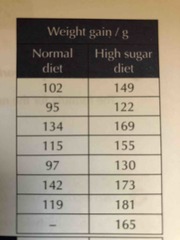
How would you work out the degrees of freedom of the above data? |
Unpaired student’s t-test dF = (n1 + n2) - 2 dF = (7 + 8) - 2 dF = 13 |
|
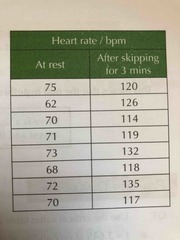
How would you work out the degrees of freedom (dF) for the above data? |
Paired student’s t-test dF = n - 1 dF = 8 - 1 dF = 7 |
|
|
You do a student’s t-test and your t value is greater than the critical value (at your degrees of freedom and a 0.01 probability level). What does this mean? |
• difference between the 2 means is significant • more than 99% probability that the results are not due to chance • reject the null hypothesis |
|
|
In what situation in a student’s t-test can you reject the null hypothesis? |
Your t-value ≥ critical value |
|
|
What is a critical value in a student’s t-test? |

The highlighted square - 3.499 |
|
|
What does a significant result mean? |
Very unlikely to be due to chance |
|
|
Define - categorical data? |
Data that falls into distinct categories. |
|
|
What is a variable? |
A Factor in an experiment that does not have a fixed value - it can be controlled, changed or measured |
|
|
In a Chi-Squared test, when can you reject the null hypothesis? |
Your Chi-squared value ≥ the critical value |
|

Work our the degrees of freedom (dF) for a Chi-Squared test? |
Table with just one row/column. dF = n - 1 dF = 4 - 3 dF = 3 |
|
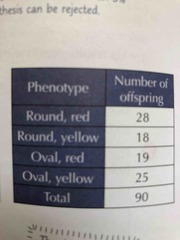
Work out the degrees of freedom (dF) for a Chi-Squared test? |
Table with just one row/column. dF = n - 1 dF = 4 - 3 dF = 3 |
|
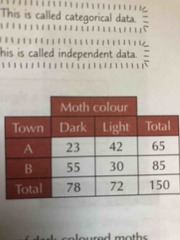
Work out the degrees of freedom (dF) for a Chi-Squared test? |
Table with more than one row. dF = (number of rows - 1) x (number of columns - 1) dF = (2 - 1) x (2 - 1) dF = 1 |
|
|
What does Chi-Squared test actually do? |
Tests whether there is significant difference between observed and expected results |
|
|
Your chi-squared value is < the critical value (at your degrees of freedom and a probability level of 0.05). What does this mean? |
• the difference between the observed and expected results is not significant • null hypothesis cannot be rejected • “the results are not significantly different from what you might expect” |
|
|
When would you use a chi-squared test? |
• Categorical data (e.g. dark and light moth colour) • The data is about frequencies • the categories don’t have any particular order (like size) • independent data - each person/plant only appears in your results once - results didn’t interfere with each other |
|
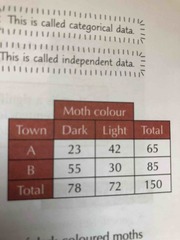
Work out the expected results in order to carry out a chi-squared test? |
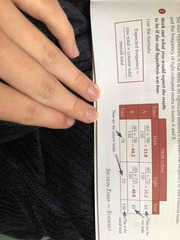
Back (Definition) |
|
|
Calculation of the index of diversity of a population will give you a positive number ≥ 1. What does an index of diversity of 1 mean? |
• All the organisms in the area are the same species • There’s no diversity |

